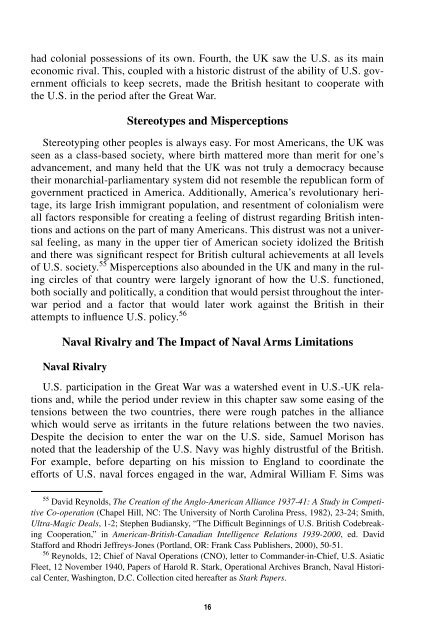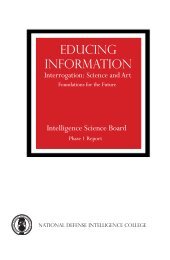Chapter 2U.S.-UK RELATIONS, 1914-1935:FROM COOPERATION TO COMPETITIONThe basis of friendship between the two great English-speaking peoplesis rivalry and independence of each other, and these are the really trueand lasting bases of all friendships. The instant the condition of dependencearises between two equals the essence of friendship is lost....Thereis no necessity for an alliance between Great Britain and the UnitedStates, and there probably never will be one, but, in effect, it exists, ormust exist, through conditions which are arising in the world and whichwill hereafter necessitate that the two countries will stand together; otherwisethey may fall together.Captain Albert P. Niblack, USN, “Forms of governmentin relation to their efficiency for war,” ProceedingsThe Historical ContextThe quote above, written by the U.S. Director of Naval <strong>Intelligence</strong> followingWorld War I, was both descriptive and prescient. While the alliance thatwould form between the U.S. and the UK between 1935 and 1945 would be oneof the closest and most enduring the world has ever known, there were many inthe U.S. who were far more focused on the rivalry that existed between the twostates. Niblack’s main argument concerned the commonalites and superiority ofthe U.S. and British forms of government and, while the development of theFascist states of Europe and Asia was still years away, he correctly saw that itwas the common values shared by the American and British people that wouldeventually overcome the tensions between the two countries. 54 What were themain sources of tension and why were they so significant in the inter-warperiod, particularly to the naval officer corps in both countries? First, even withthe war experience behind them, many in the U.S. and the UK had little firsthandknowledge about each other and their perceptions of one another were rifewith stereotypes and misconceptions. Second, while the seeds of naval operationaland intelligence cooperation were planted during the period of the GreatWar, many U.S. naval officers saw the Royal Navy as their principal rival andthe British felt threatened by a U.S. policy committed to building a “Navy secondto none.” Third, Great Britain was seen by many in the U.S. as representingcolonialism, a practice most Americans despised, despite the fact that the U.S.54 Albert P. Niblack, CAPT, USN, “Forms of government in relation to their efficiency for war,”Proceedings 46 (September 1920): 1402-1430.15
had colonial possessions of its own. Fourth, the UK saw the U.S. as its maineconomic rival. This, coupled with a historic distrust of the ability of U.S. governmentofficials to keep secrets, made the British hesitant to cooperate withthe U.S. in the period after the Great War.Stereotypes and MisperceptionsStereotyping other peoples is always easy. For most Americans, the UK wasseen as a class-based society, where birth mattered more than merit for one’sadvancement, and many held that the UK was not truly a democracy becausetheir monarchial-parliamentary system did not resemble the republican form ofgovernment practiced in America. Additionally, America’s revolutionary heritage,its large Irish immigrant population, and resentment of colonialism wereall factors responsible for creating a feeling of distrust regarding British intentionsand actions on the part of many Americans. This distrust was not a universalfeeling, as many in the upper tier of American society idolized the Britishand there was significant respect for British cultural achievements at all levelsof U.S. society. 55 Misperceptions also abounded in the UK and many in the rulingcircles of that country were largely ignorant of how the U.S. functioned,both socially and politically, a condition that would persist throughout the interwarperiod and a factor that would later work against the British in theirattempts to influence U.S. policy. 56Naval Rivalry and The Impact of Naval Arms LimitationsNaval RivalryU.S. participation in the Great War was a watershed event in U.S.-UK relationsand, while the period under review in this chapter saw some easing of thetensions between the two countries, there were rough patches in the alliancewhich would serve as irritants in the future relations between the two navies.Despite the decision to enter the war on the U.S. side, Samuel Morison hasnoted that the leadership of the U.S. Navy was highly distrustful of the British.For example, before departing on his mission to England to coordinate theefforts of U.S. naval forces engaged in the war, Admiral William F. Sims was55 David Reynolds, The Creation of the Anglo-American Alliance 1937-41: A Study in CompetitiveCo-operation (Chapel Hill, NC: The <strong>University</strong> of North Carolina Press, 1982), 23-24; Smith,Ultra-Magic Deals, 1-2; Stephen Budiansky, “The Difficult Beginnings of U.S. British CodebreakingCooperation,” in American-British-Canadian <strong>Intelligence</strong> Relations 1939-2000, ed. DavidStafford and Rhodri Jeffreys-Jones (Portland, OR: Frank Cass Publishers, 2000), 50-51.56 Reynolds, 12; Chief of Naval Operations (CNO), letter to Commander-in-Chief, U.S. AsiaticFleet, 12 November 1940, Papers of Harold R. Stark, Operational Archives Branch, Naval HistoricalCenter, Washington, D.C. Collection cited hereafter as Stark Papers.16
- Page 1 and 2: COURTING A RELUCTANT ALLYAn Evaluat
- Page 4: The Joint Military Intelligence Col
- Page 8 and 9: FOREWORDTo most Americans alive tod
- Page 10 and 11: PROLOGUESince World War II, the Uni
- Page 12 and 13: Chapter 1THE STATUS OF INTELLIGENCE
- Page 14 and 15: action, a propaganda unit, or an ec
- Page 16 and 17: officers assisted by 20 civilian cl
- Page 18 and 19: ships in violation of treaty limits
- Page 20 and 21: assessments. By 1941, ONI was releg
- Page 22 and 23: might bear on their work.” 39 As
- Page 24 and 25: ility over time, its operational in
- Page 28 and 29: told by the Chief of Naval Operatio
- Page 30 and 31: ups of the early 20th century. 65 T
- Page 32 and 33: firmly believed that British polici
- Page 34: ecame one of the primary sources of
- Page 37 and 38: of shoring up their strategic weakn
- Page 39 and 40: mon framework for negotiation with
- Page 43 and 44: assuaged British concerns about the
- Page 45 and 46: In the area of intelligence exchang
- Page 47 and 48: clear to the Americans that if they
- Page 49 and 50: in his mind worked against closer c
- Page 51 and 52: praised the fighting spirit of the
- Page 53 and 54: through November of 1940 persuaded
- Page 55 and 56: and Great Britain. His principalcon
- Page 57 and 58: eceived by the British and from the
- Page 59 and 60: gear designed by the British. Altho
- Page 61 and 62: American Attitudes On Intelligence
- Page 63 and 64: information did have an impact on K
- Page 65 and 66: the affair. 183 This lack of resent
- Page 67 and 68: tion exchanges. Even more significa
- Page 69 and 70: nation (BSC) mission, is now availa
- Page 71 and 72: good will and encouraged greater co
- Page 73 and 74: would merely show Donovan “the be
- Page 75 and 76: Lothian passed Hill’s proposal to
- Page 77 and 78:
still a powerful influence. While Z
- Page 79 and 80:
Since the Tizard Mission had only a
- Page 81 and 82:
appropriating large increases to th
- Page 83 and 84:
the French, a point which would not
- Page 85 and 86:
equested that RADM Ghormley remain
- Page 87 and 88:
when he [Pott] comes to O.N.I. he i
- Page 89 and 90:
it was not official U.S. policy. St
- Page 91 and 92:
efforts that had begun with the Sta
- Page 93 and 94:
high-level ABC-1 staff talks which
- Page 95 and 96:
to successfully interpret the instr
- Page 97 and 98:
to little more than a nebulous stat
- Page 99 and 100:
to offer.” 319 Others in the Brit
- Page 101 and 102:
Operational Intelligence Cooperatio
- Page 103 and 104:
Godfrey’s main concern was most l
- Page 105 and 106:
possesses complementary capabilitie
- Page 107 and 108:
2. Be prepared to give something of
- Page 109 and 110:
had in forming its own Joint Intell
- Page 112 and 113:
GLOSSARYABC-1ALUSNALondonBGENBSCCAP
- Page 114 and 115:
APPENDIX AA NOTE ON SOURCESArchival
- Page 116:
APPENDIX BMAJOR EVENTS IN U.S.-UK I
- Page 119 and 120:
________. Foreign Relations of the
- Page 121 and 122:
________. “The Secret of the Chur
- Page 123 and 124:
Zacharias, Ellis M., CAPT, USN. Sec
- Page 126 and 127:
INDEXAABC-1 Talks 41, 57, 74-75, 78
- Page 128 and 129:
IImagery Intelligence (IMINT) 12, 8
- Page 130 and 131:
Signals Intelligence(SIGINT) 2-3, 7
- Page 132:
PCN 53512ISBN 0-9656195-9-1
















